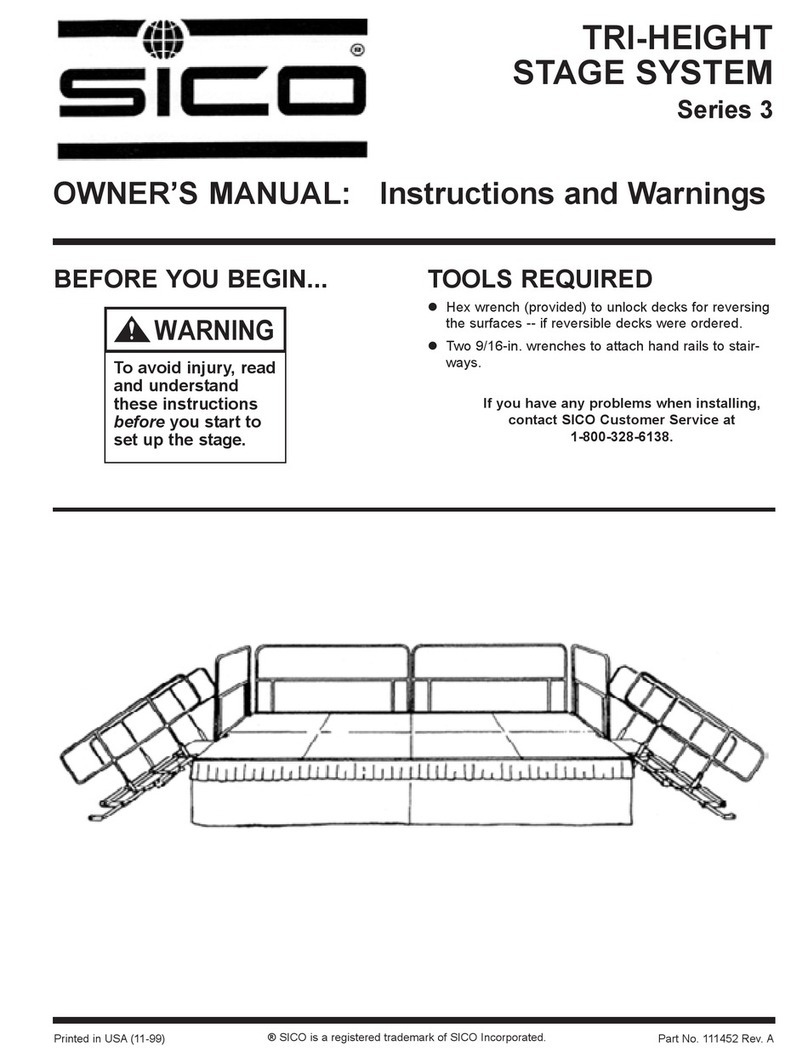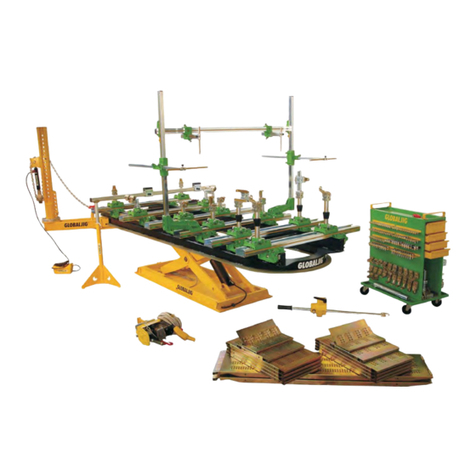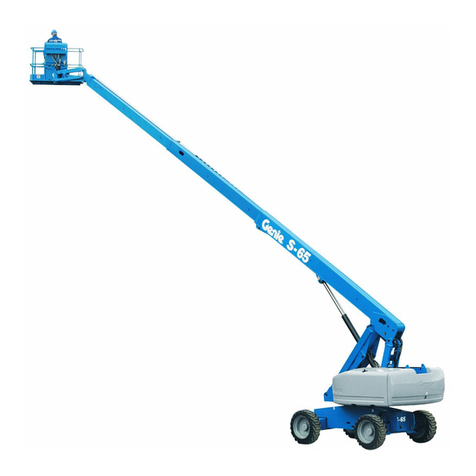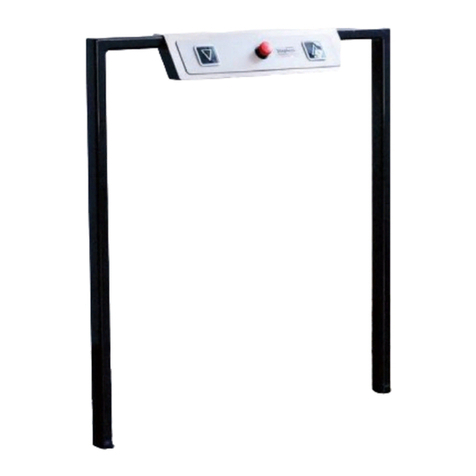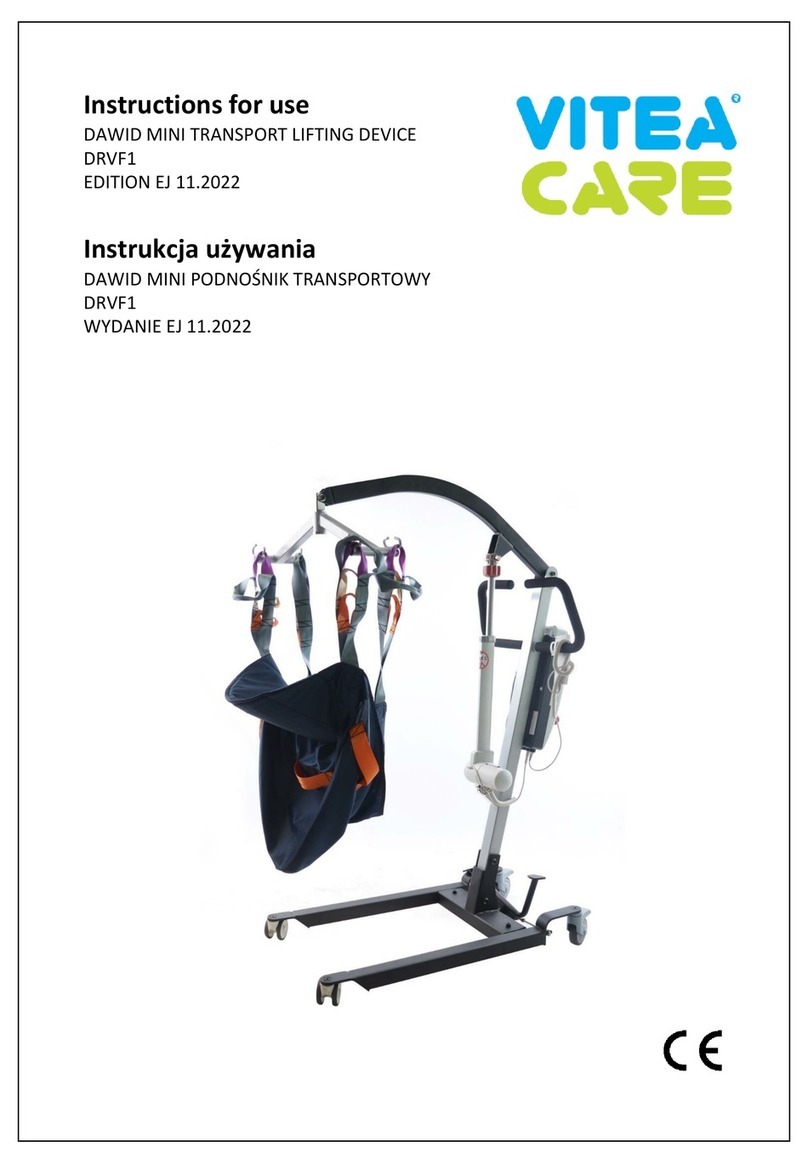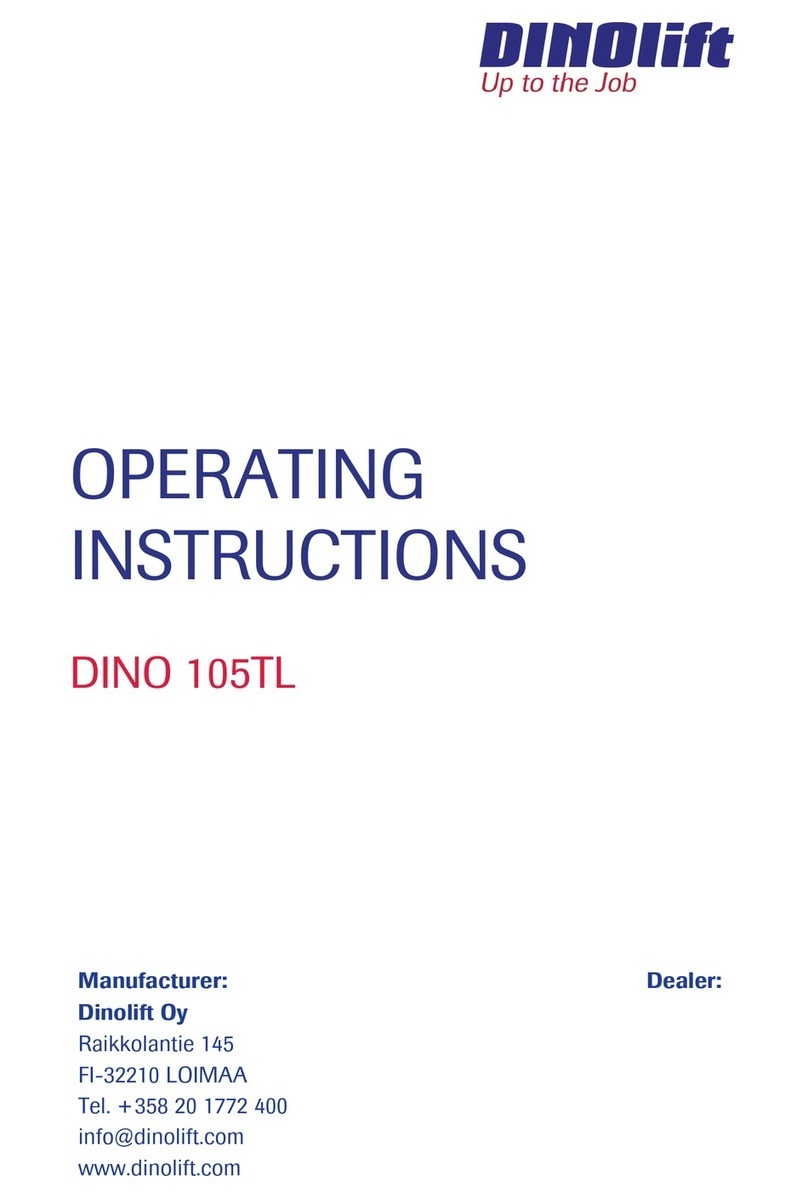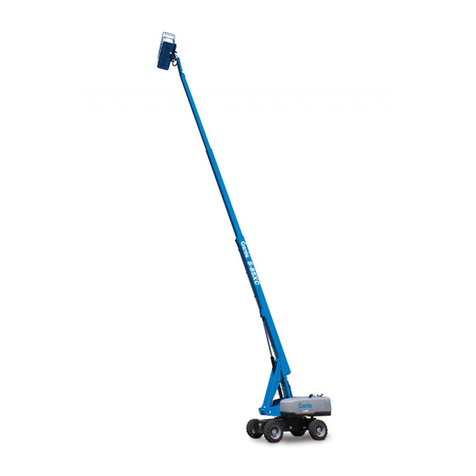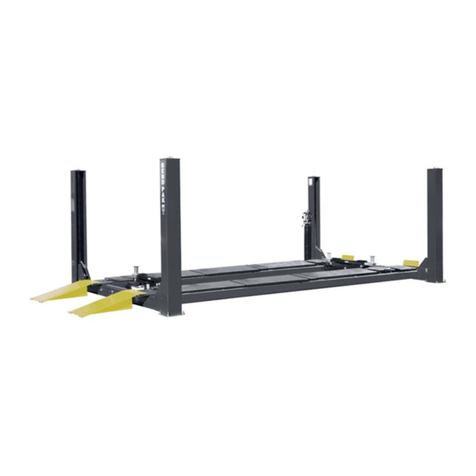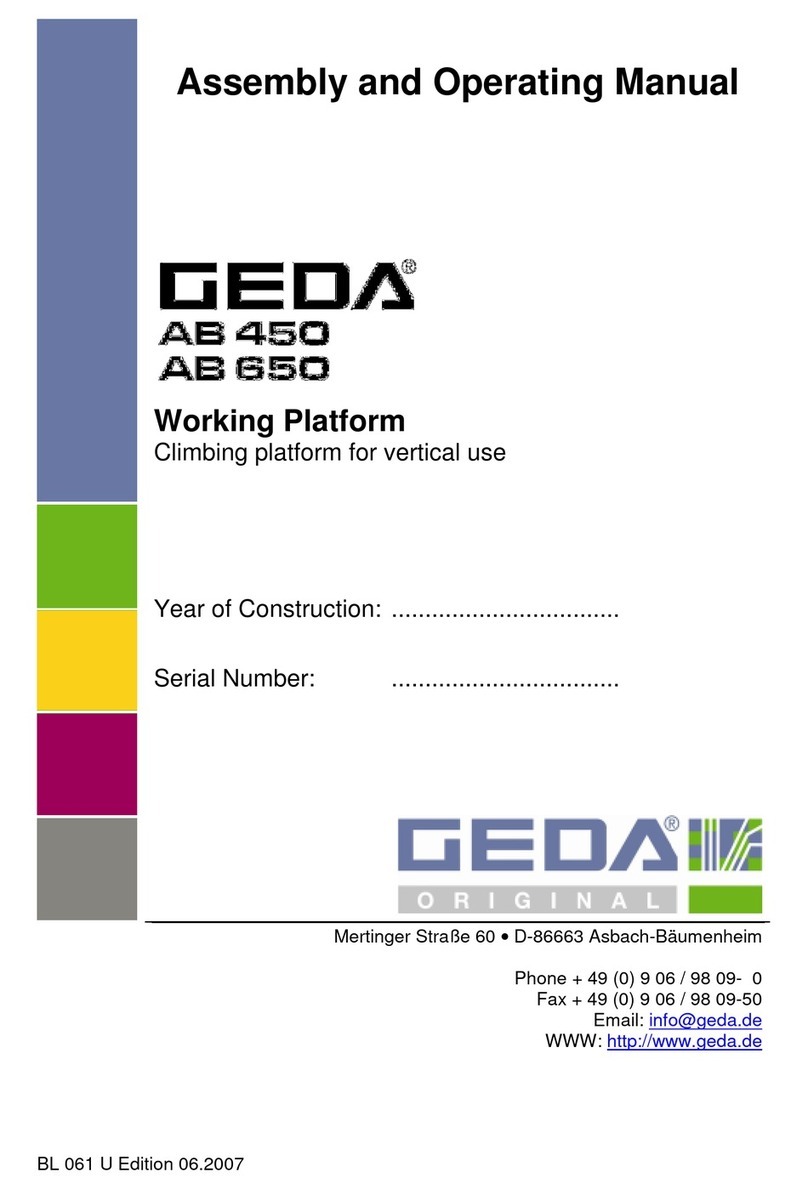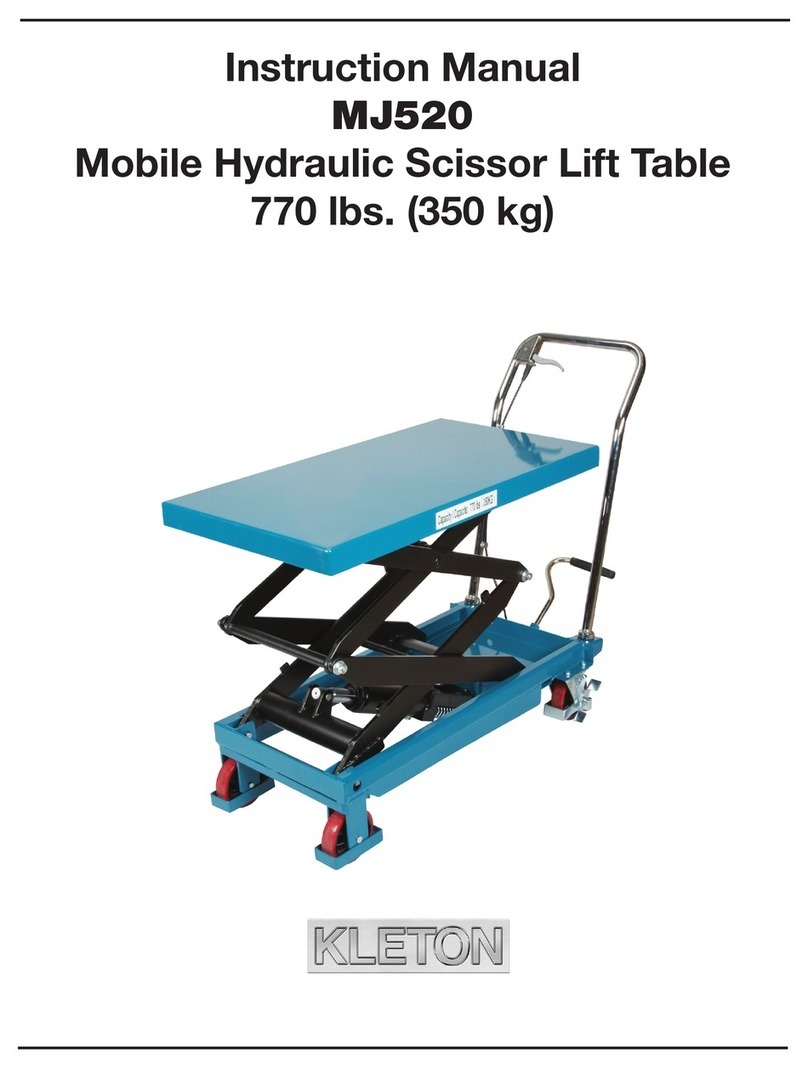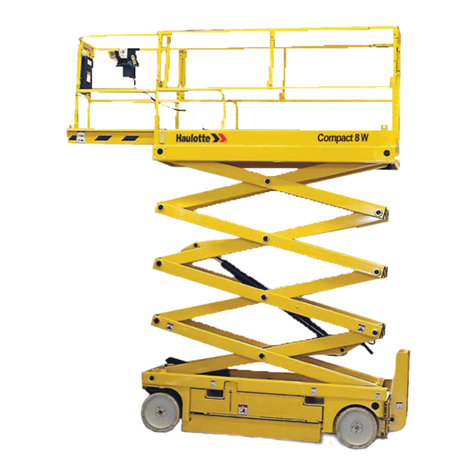SICO 3 Series User manual

SERIES 3RAMP
OWNER’S MANUAL
® SICO is a registered trademark of SICO Incorporated Part No. 117675 Rev. E
BEFORE YOU BEGIN . . .
Read and understand these instructions before
beginning a ramp setup.
Use caution and care for your back when lifting,
pushing, pulling, folding or unfolding your SICO®
ramp system. Never lift more than you are able to
safely handle.
SICO’s®ramp system is designed to comply with
ADA requirements, including a maximum slope
not exceeding 1” [25 mm] of elevation change
per foot [30.5 cm] of horizontal distance traveled.
The ramp system can be connected to any SICO®
portable stage.
TOOLS REQUIRED:
• T-Handle 8 mm [5/16”] hex wrench – provided.
• 8 mm or 5/16” socket or box end or open end
wrench.
• 17 mm socket or box end or open end wrench.
• 5 mm hex driver.
• Optional: Drill with 8 mm (5/16”) socket and hex
driver.
• T-Handle: 3 mm provided with turnaround kit.
If you have any problems or questions during setup,
contact SICO® Customer Care at 1-800-424-0796.

PAGE 2
INTRODUCTION
WEDGE SECTION
BRIDGE SECTION
FOLDING LEG SECTION
UPPER CLAMP
ASSEMBLY
RAMP CADDY
INTRODUCTION:
SICO’s®ramp system is a modular system that is
designed to connect to any SICO®portable stage.
Modules are available with either 6” [15.2 cm] or 8”
[20.3 cm] height increments up to 72” [183 cm] high
to match the height or the range of heights of your
SICO®portable stage. The ramp system includes
the ramp surface, handrails and all hardware that is
required.
A typical ramp system consists of:
• A 0”-6” [0-15.2 cm] or a 0”-8” [0-20.3 cm] wedge
section;
• A 72-3/8” [184cm] or 96-3/8” [245 cm] bridge
section;
• One or more 72-3/8” [184 cm] or 96-3/8” [245 cm]
folding leg sections;
• Right hand and left hand handrails for each ramp
section;
• An upper clamp for connecting the top ramp
section to the stage or ramp landing;
• Optional caddy for storing the ramp system and
for transporting the ramp system between the
storage location and the stage location.
ADA requires that ramp runs be no more than 30 feet
[9.14m] long, so ramps higher than 30” [76cm] will
require one or more ramp landings or turnarounds.
Space considerations may require turnarounds on
lower ramp systems. Each landing or turnaround
requires additional guardrails, an upper and a lower
clamp assembly and may require enter and exit
handles, and a handrail U-turn.
A typical ramp turnaround, where direction of travel
changes by 180 degrees, consists of two 3’x8’ [0.9m
x 2.4m] folding leg platforms, but could be a single
6’x8’ [1.8m x 2.4m] SICO® 1800 Series or Tri-Height
portable stage. A typical ramp landing, where direc-
tion of travel does not change, could consist of any
4’x8’ [1.2m x 2.4m] SICO®portable stage. If a ramp
landing is at the same height as the main stage and
is different from the main stage, a landing to stage
connector will be required. Note that a 60” [152 cm]
turning circle is required when there is a change in
the direction of travel.

PAGE 3
HANDLING YOUR SICO®RAMP
WHEN HANDLING YOUR RAMP, REMEMBER
TO:
1. Use two people to safely move and handle the ramp
sections.
2. To prevent injury, be careful to not drop ramp
sections. Damage to the ramp may also occur.
3. When setting up a ramp systems, always start at
the top end and work section by section toward the
bottom wedge section.
4. When taking a ramp system down, start at the
bottom (i.e., wedge) section.
5. Do not attempt to move ramp sections after they
are connected to the stage or other ramp sections.

PAGE 4
INSTALLATION OVERVIEW
Detailed instructions begin on the next page.
1. Plan the layout of the portable stages and the ramp
system.
2. Set up the stage system. See the instructions
supplied with the stage.
3. If there is a top landing, set up the top landing and
install the landing to stage connector, if required.
4. Attach the upper clamp assembly to the landing or
stage.
5. Connect the tallest ramp section to the upper clamp
assembly. Note the legs of the folding leg ramp
sections are toward the bottom of the ramp section.
Connect additional ramp sections as required by the
ramp layout.
6. If a ramp landing or turnaround is included in the
layout, set up the landing or turnaround, attach a
lower clamp assembly to the landing or turnaround
and connect the landing or platform to the bottom
end of the ramp section.
7. Repeat steps 4 through 6 as required for the ramp
layout.
8. When only the bridge section and wedge section
are left to install, position the wedge section and
then connect the bridge section between the wedge
section and the lowest folding leg section.
9. Install handrails and guardrails.

PAGE 5
PLAN THE RAMP LAYOUT
3. Ramp with Two Turnarounds
2. Ramp with Turnarounds
Guardrail or Stage to stage connector, if required
Guardrail or Stage to stage connector, if required
Guardrail
Guardrail
Folding Leg
Section
Folding Leg
Section
Folding Leg
Section Folding Leg
Section Folding Leg
Section
Folding Leg
Section
Folding Leg
Section
Folding Leg
Section
Folding Leg
Section
Folding Leg
Section
Bridge
Section
Bridge
Section
Turnaround
Section
Turnaround
Section
Turnaround
Section
Turnaround
Section
Turnaround
Section
Turnaround
Section
Wedge
Section
Wedge
Section
Handrail or
Guardrail
Handrail or
Guardrail
Handrail
Handrail
1. Straight Ramp System
Guardrail or Stage to stage connector, if required
Guardrail
Exit handle
Landing
or
Stage
Folding Leg
Section Bridge
Section Wedge
Section
Enter Handle
Handrail or
Guardrail HandrailUpper clamp assembly
Landing
or
Stage
Landing
or
Stage
Handrail or
Guardrail
Upper clamp
assembly
Upper clamp
assembly
Lower clamp
assembly
Guardrail
Guardrail
Enter Handle Upper clamp assembly
Upper clamp assembly
Lower clamp
assembly
Handrail or
Guardrail
Enter Handle
The exibility designed
into your SICO®ramp
system makes it possible
to set the ramp system
up in many different con-
gurations, particularly
the longer ramp systems.
If you need assistance
with designing a ramp
conguration for your site,
please contact your SICO®
sales representative or
SICO’s®Customer Care
Department (see contact
information on last page).
A few examples are
illustrated here.
1. Straight ramp system
that connects to a ramp
landing or directly to a
stage section without any
changes in the direction
of travel. This option is
limited to a maximum
ramp height of 30" [76 cm]
per ADA requirements.
(See layout 1)
2. A ramp with a turn-
around. The upper end
of the uppermost ran run
may connect to a SICO®
ramp landing or a SICO®
portable stage unit. (See
layout 2)
3. Ramp systems
more than 60" [152cm]
high must have at least
two landings or turn-
arounds. (See layout 3)
Note that turns in the
opposite direction to what
is shown can be set up
with the same equipment.

PAGE 6
TOP LANDING INSTRUCTIONS
1. If the ramp will connect directly to the
stage without a separate landing, skip
this section and proceed to attaching the
upper clamp assembly.
2. If the top landing is the same type of
stage as the main stage units, set up the
landing unit and connect it to the main
stage units with the stage unit to unit
connectors; skip the rest of this section
and proceed to attaching the upper
clamp assembly.
3. If the top landing is a different type of
stage than the main stage units, a
landing to stage connector is required.
The width of this connector must match
the width of the landing edge that
connects to the main stage units.
4. Place the connector rmly against the
stage edge at the desired location.
Using the provided T-handle hex
wrench, tighten the socket head cap
screws for the two clamps directed
toward the main stage unit. Firm
pressure is needed to ensure the
connector is solidly attached to the
stage. Do not over tighten to prevent
damage to the stage.
5. Position the landing rmly against the
connector and tighten the screws for the
two clamps directed toward the landing.
LANDING TO STAGE CONNECTOR
LANDING & STAGE CONNECTED
LANDING TO STAGE CONNECTOR
ATTACHED TO STAGE

PAGE 7
UPPER CLAMP ASSEMBLY INSTRUCTIONS
INSTALLED UPPER CLAMP ASSEMBLY
INSTALLED UPPER CLAMP ASSEMBLY
The upper clamp assembly provides a
secure attachment of the upper end of the
highest ramp section.
To attach the upper clamp assembly:
1. Place the upper clamp assembly
against the edge of the stage or ramp
landing with the top tubular member
rmly against the stage or landing.
2. Using the provided T-handle hex
wrench, tighten the two socket head
cap screws on the top of the clamp
assembly. Firm pressure is needed to
ensure the clamp is solidly attached.
Do not over tighten to prevent damage
to the stage or landing.
3. Disengage the two hitch pins from the
holes in the clamp assembly.

PAGE 8
ATTACH THE FIRST RAMP SECTION
Note: Use the optional SICO®caddies to
save time and effort.
1. Move the loaded ramp caddy to near
where the ramp section will be set up.
Lock the caddy casters to keep the
caddy from moving while unloading the
ramp sections.
2. Ramps with three or more sections will
have at least one section with folding
legs. The ramp section with the
longest legs is the rst section to install.
3. With the ramp section on the caddy,
release the leg brace locking pins by
rotating the two yellow handles until the
handles are perpendicular to the legs.
See Figure 1.
4. Partially extend the legs as shown in
Figure 2.
5. Rotate the yellow handles to their
original position.
6. Swing the legs fully out until both
locking pins engage in the leg braces.
7. While holding the ramp section in
place, lift the lock on the caddy to
release the deck.
See Figure 3.
8. Rotate the deck until one of the legs
contacts the oor.
9. With one person at each end of the
ramp section, pivot the ramp off the
caddy so that is rests on its legs and
the upper attachment brackets.
See Figure 4.
FIGURE 1
FIGURE 2
FIGURE 3
FIGURE 4

PAGE 9
ATTACH THE FIRST RAMP SECTION (CONTINUED)
10. With a person on each side of the ramp, lift the
upper end of the ramp (i.e., the end without the
legs) so that it is slightly higher than the stage
or landing to which it will connect.
11. Pull the ramp section toward the upper clamp
until the ramp section brackets are against the
at plates of the upper clamp assembly.
12. Lower the ramp onto the support plate.
13. Secure the ramp in place using the hitch pins
that are part of the upper clamp assembly.
14. If the ramp is on an uneven oor, adjust the
glides to level the ramp as needed.
ATTACHING THE NEXT RAMP SECTION
1. If the next section is a ramp section with folding
legs (i.e., not a landing or turnaround or the bridge
ramp section or wedge ramp section), connect
the second ramp section to the bottom end of the
rst ramp section the same way the rst ramp
section was attached to the upper clamp.
2. Repeat this process until the next piece of the
ramp system is either the bridge section or a
landing or a turnaround.
3. If the next section of the ramp system is the bridge
section, skip the next section on turnarounds and
landings.
RAMP CONNECTED TO UPPER CLAMP ASSEMBLY
SECURE RAMP IN PLACE USING HITCH PINS

PAGE 10
TURNAROUNDS AND LANDINGS
Landings and turnarounds are ADA requirements
for longer ramps systems. They are also used to
change the direction of travel as required to t
within the building’s dimensions; see the section
on planning the ramp layout.
1. Set up the stage unit(s) that will function as
the landing or turnaround at the desired
height. Refer to the operating manual
provided with that product for additional
information regarding that product. If two 3'
x 8' [0.91 x 2.44m] folding leg units serve as
the turnaround, connect them to each other
with the rotolocks.
2. Attach the lower clamp assembly to the edge
of the landing or turnaround where the upper
ramps sections will connect; the clamp
attaches the same way the upper clamp was
installed.
3. Attach an upper clamp assembly to the
edge of the landing or turnaround in the
location where the lower ramp sections will
connect to the landing or turnaround.
4. Move the landing or turnaround so the lower
clamp assembly is adjacent to the bottom
edge of the ramp section that has already
been set up.
5. If necessary, adjust the glides in the landing
or turnaround and the ramp section until the
heights match.
LOWER CLAMP ASSEMBLY ATTACHED TO RAMP
LANDING
RAMP LANDING CONNECTED TO RAMP WITH
LOWER CLAMP ASSEMBLY
RAMP LANDING

PAGE 11
TURNAROUNDS AND LANDINGS - continued
UPPER CLAMP ASSEMBLY INSTALLED ON RAMP
LANDING 6. Lift the landing or turnaround slightly as you slide
it toward the bottom edge of the ramp section
and engage the lower clamp assembly onto the
bottom end of the ramp section.
7. Attach the next ramp section to the landing or
turnaround in the same manner as the earlier
ramp sections were installed.
8. Install additional ramp sections as required until
another landing or turnaround is reached or until
the next section is the bridge section. If the next
part of the ramp system is a landing or turn
around, repeat the steps in this section. If the
next section is the bridge section, proceed to the
next section.

PAGE 12
BRIDGE & WEDGE SECTION INSTALLATION
The bottom two sections of the ramp are the
bridge section and the wedge section.
1. Tilt the bridge section off the ramp caddy so
the bridge section is resting on all four
connector brackets that are mounted near
the four corners. See Figure 1.
2. Lift one edge of the bridge section and insert
the two brackets into the brackets on the
bottom edge of the lowest folding leg ramp
section or the upper clamp of a landing or
turnaround. See Figure 2.
3. Place the wedge ramp section adjacent to the
bottom edge of the bridge ramp section.
Remove the hitch pins from the holes in the
wedge section connector brackets.
See Figure 3.
4. With one person on each side, lift the low
end of the bridge section while pulling the
wedge section toward the bridge section until
the bridge section brackets contact the
vertical plates of the wedge section and the
lower the bridge section brackets into the
wedge section brackets. See Figure 4.
5. Secure all four corners of the bridge section
by installing the hitch pins. See Figure 5.
FIGURE 1
FIGURE 2
FIGURE 3
FIGURE 4
FIGURE 5

PAGE 13
The connector at the upper end of the wedge ramp
section is designed to connect to the lower end of
the bridge ramp section. When the wedge ramp
section connects to a stage or landing or turnaround,
two special connectors (part number 118309B) are
required to connect the wedge ramp section to an
upper clamp assembly.
1. Pin the square tube end of both of the special
connectors to the wedge ramp section assembly
using the hitch pins.
2. Push the wedge ramp section with the special
connectors attached against the upper clamp
assembly.
3. Secure the special connectors now attached
to the wedge ramp section to the upper clamp
assembly with the hitch pins.
SPECIAL CONNECTORS
SPECIAL CONNECTOR ATTACHED TO WEDGE
RAMP SECTION
WHEN THE WEDGE RAMP SECTION CONNECTS TO A
LANDING OR TURNAROUND OR STAGE

PAGE 14
ATTACHING GUARDRAILS
ALWAYS install guardrails and connect
handrails of adjacent guardrails to provide
a continuous handrail and to prevent ramp
sections from separating from each other.
Failure to do so may result in serious injury
or death.
WARNING
IMPORTANT: Guardrails and handrails are
critical safety features of any ramp and
stage. Handrails on the SICO Series 2
ramps also serve to lock the ramp sections
together, essentially created one integral
ramp system.
Ramp handrails/guardrails come in right
hand and left hand versions. When installed
correctly on the ramp, the posts will be
vertical.
1. Lay out the handrails and guardrails
next to where they will be installed.
2. It is typically easiest to start from the top
of the ramp and work your way down,
usually with the Inside rails rst.
WARNING
Use only metric 10mm bolts to connect the
guardrails to the decks. 3/8”-16 bolts will
engage the threads of the metric nut but
may strip out under load resulting in injury
or death.
Contact SICO®Customer Care for
replacement parts if the provided bolts
are lost or damaged.

PAGE 15
ATTACHING GUARDRAILS
3. Place the rst handrail on the ramp surface
with the handrail toward the center of the
ramp section. Note that the posts should be
vertical; if they are not, use that guardrail on
the opposite side of the ramp.
4. Align the holes in the guardrail mounting
plates with the holes in the top of the ramp.
5. Attach the guardrail to the ramp using two
at washers and two M10-1.5 x 110mm
[4.33”] socket head screws; there are M10-1.5
nuts on the underside of the ramp deck.
6. Using the 8mm [5/16”] T-handle hex wrench
provided, tighten the two screws enough to
keep the handrail standing vertically. It will
be easier to connect other handrails and/or
guardrails if the screws are not tight. They
will be tightened later.
7. If there is another ramp section before
coming to a landing or the wedge section,
install a 5” [13cm] long straight locating sleeve
in the bottom end of the handrail tube. Insert
half of the locating sleeve into the handrail
tube, and install a self-tapping screw to
secure the sleeve to the handrail. A drill with
an 8 mm (5/16") hex driver recommended.
The locating sleeve normally does not need to
be disassembled when the ramp is taken
down.
8. Place the handrail for the next section of ramp
on the ramp surface. Align the upper end of
the handrail with the locating sleeve and push
the handrail so the handrail engages the
locating sleeve. Then, align the holes in
the guardrail mounting plates with the holes in
the deck, install two at washers and two
M10-2x110mm screws and tighten just
enough so the guardrail stands reasonably
straight.
HANDRAIL WITH LOCATING SLEEVE INSTALLED

PAGE 16
ATTACHING GUARDRAILS - continued
9. Repeat steps 7 & 8 until you get either to a landing
or the wedge section.
10. Repeat steps 3 through 9 for the opposite side
of the ramp and for the other runs of ramp until
you get to the wedge (bottom) ramp section.
11. If the wedge ramp section is not connected to
the bridge section, skip this step. Otherwise,
install locating sleeves into the bottom end left
hand and right hand handrails that are mounted
on the bridge section as directed in step 7 above.
12. Position one of the bottom ramp guardrails on
the ramp and engage the upper end of its handrail
with the locating sleeve.
13. Attach the upper end of the guardrail to the
ramp wedge section with a at washer and an
M10-1.5x60mm [2.36”] socket head screw.
14. Insert a 10mm carriage bolt (see picture) into the
slot at the bottom edge of the ramp with the
thread end facing up. Set the guardrail mounting
plate hole over the carriage bolt and install a at
washer and 10mm nut. It may be necessary to
lift up slightly on the guardrail for the slot at the
bottom edge of the wedge ramp section to
capture the square neck of the carriage bolt
during the initial tightening.
15. Repeat steps 12 through 14 for the other bottom
guardrail.
16. If the ramp system has a turnaround with a 180
degree direction change, install a handrail U-turn
piece between the two adjacent handrails.
Attached an angled sleeve to the bottom end of
the handrail with a self-drilling screw, making
certain that the end of the angled sleeve is
horizontal. Attach an angled sleeve to the upper
handrail, again making certain that the end of the
angled sleeve is horizontal. Install the ends of the
U-turn over the two angled sleeve. Secure by
tightening the two setscrews using the 3 mm
T-handle hex wrench.
INSTALLED WEDGE RAMP SECTION GUARDRAIL

PAGE 17
ATTACHING GUARDRAILS - continued
17. If the ramp system has landings or turnarounds with
guardrails with integral handrails, insert an angled
locating sleeve into the end of the handrail of the
ramp guardrail, and attach it with a self-drilling
screw. Engage the handrail of the landing guard
rail with the angled locating sleeve. Attach the land
ing guardrail to the landing with two at washers
and two M10-1.5x60mm [2.36”] screws and tighten
just enough so the guardrail stands reasonably
straight.
18. Repeat step 17 for the other landing and turnaround
guardrails with integral handrails.
19. Tighten all of the guardrail mounting screws. All
of the guardrails with integral handrails should now
be securely fastened.
20. Install the other landing guardrails per the
instructions included with them. All edges of the
ramp and the landings should now have guardrails
installed and securely fastened.
21. Install enter handles on the two ramp guardrails
installed on the wedge (bottom) ramp section.
Enter handles have the locating sleeve angled
upwards. Insert the locating sleeve into the end of
the handrail. Secure the bottom end to the guard
rail post with an M10x1.5x60mm [2.33”] hex head
screw, leaving it a bit loose for now. Secure the top
end to the handrail with a self-drilling screw. Then
tighten the hex head screw.
22. Install another enter handle on the other bottom
guardrail.
23. If required, install enter handles on the bottom
ends of ramp guardrails that terminate at a landing
or turnaround.
24. Install exit handles at the top end of ramp guard
rails. These are similar to the enter handles except
the locating sleeve is angled down.

PAGE 18
DISSASSEMBLING THE RAMP
Disassembly of the ramp is basically the
reverse of the assembly procedure, starting
with the guardrails at the bottom end of the
ramp. Enter and exit handles do not need to
be removed. The carriage bolts at the bottom
end of the bottom guardrails just have to be
loosened and can stay with the guardrails.
The locating sleeves between guardrails do
not need to be removed. Loosen the two
setscrews on the handrail U-turn and remove
the U-turn. As each handrail and guardrail is
removed, be sure to install the attachment
hardware to the ramp or platform so that it is
available the next time the ramp is set up.
Put the handrails and guardrails on the
optional caddy.
After the guardrails are removed and stored,
start disassembly of the ramp from the bottom
wedge section. As each ramp and landing
section is disconnected from the rest of the
ramp system, install it onto the optional caddy.

PAGE 19
Notes:

PAGE 20
Notes:
Please have the serial number of the
product when contacting customer service.
To receive assistance for:
- Selecting replacement parts / decals
- Repairing the product
- Adjusting and operating the product
- Obtaining on-line assistance
TELEPHONE: 1-800-424-0796
FAX: (952) 829-5141
WEB SITE: WWW.SICOINC.COM
SICO AMERICA INC.
7525 Cahill Road
Minneapolis, MN 55439 USA
Other manuals for 3 Series
1
Table of contents
Languages:
Other SICO Lifting System manuals
